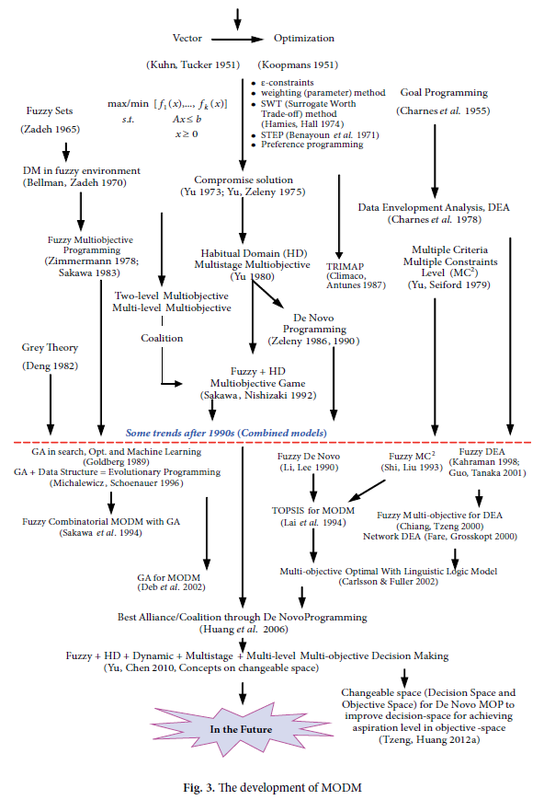| Gwo-Hshiung Tzeng New Concepts and Trends of Hybrid MCDM for Tomorrow |
|
-
Theories
- New concepts and trends of MCDM for tomorrow - in honor of Professor Gwo-Hshiung Tzeng on the occasion of his 70th birthday
- COMMENTS ON “MULTIPLE CRITERIA DECISION MAKING (MCDM) METHODS IN ECONOMICS: AN OVERVIEW”
- New thinking of multi-objective programming with changeable space – in search of excellence
- A Hybrid Dynamic MADM Model for Problem-Improvement in Economics and Business
- A Fuzzy Integral-based Model for Supplier Evaluation and Improvement
- New Combined Hybrid Approaches
- DEMATEL and DANP
- Vitae
- News !
- Publications
- Lectures
-
MCDM
- Websites >
-
Fuzzy (IJFS)
>
- FMCDM with Fuzzy DEMATEL Approach for Customers' Choice Behavior Model
- A Novel Method for Fuzzy Measure Identification
- Combining Hybrid MADM with Fuzzy Integral for Exploring the Smart Phone Improvement in M-Generation
- Environmental Strategic Orientations for Improving Green Innovation Performance in Fuzzy Environment - Using New Fuzzy Hybrid MCDM Model
- DRSA-Based Neuro-Fuzzy Inference Systems for the Financial Performance Prediction of Commercial Banks
- New Books
- Contact
J. H. Liou & Gwo-Hshiung Tzeng (2012) Comments on “Multiple criteria decision making (MCDM) methods in economics: an overview”, Technological and Economic Development of Economy, 18:4, 672-695, DOI: 10.3846/20294913.2012.753489
COMMENTS ON “MULTIPLE CRITERIA
DECISION MAKING (MCDM) METHODS IN ECONOMICS: AN OVERVIEW”
James J.H. Liou1, Gwo-Hshiung Tzeng2,3
James J.H. Liou1, Gwo-Hshiung Tzeng2,3
Abstract. This paper offers some comments on a previously published paper entitled
“Multiple criteria decision making (MCDM) methods in economics: an overview” by
Zavadskas and Turskis (2011). The authors of that work did make great efforts
to summarize MCDM methods, but we feel that they ignored some important new concepts
and trends in the MCDM field for solving real-world problems. First, the traditional
model assumes that the criteria are independent and hierarchical in structure; however,
in real-world problems, the relationships between the criteria or dimensions
are usually interdependent and sometimes even exert feedback effects. Second, the relative good solution from the existing
alternatives is replaced by the aspiration levels to fit today’s competitive
markets. Third, the trends have shifted from how to carry out the “ranking”
or “selection” of the most preferable alternatives, to how to “improve” their
performances. Fourth, information fusion/aggregation such as fuzzy integrals, basically,
a non-additive/super-additive model, has been developed to aggregate the
performances. Finally, the original fixed resource in multi-objective
programming is divided, so that both decision and objective spaces are
changeable. In this paper we add some new concepts and provide comments that could
be seen as completing the original paper.
Keywords: MCDM (Multiple Criteria Decision Making), Interdependence, Information fusion, Non-additive, Changeable space, Economics
Keywords: MCDM (Multiple Criteria Decision Making), Interdependence, Information fusion, Non-additive, Changeable space, Economics




